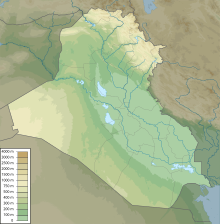| Siege of Kut | |||||||
|---|---|---|---|---|---|---|---|
| Part of the Mesopotamian campaign of World War I | |||||||
 Charles Townshend and Halil Pasha after the fall of Kut | |||||||
| |||||||
| Belligerents | |||||||
|
|
| ||||||
| Commanders and leaders | |||||||
|
|
| ||||||
| Strength | |||||||
| 25,000–45,000 besieged in Kut | 25,000[1]–80,000[2] | ||||||
| Casualties and losses | |||||||
| Entire garrison[a] | 10,000 men[5] | ||||||
Location within Iraq | |||||||
The siege of Kut Al Amara (7 December 1915 – 29 April 1916), also known as the first battle of Kut, was the besieging of an 8,000-strong British Army garrison in the town of Kut, 160 km (100 mi) south of Baghdad, by the Ottoman Army. In 1915, its population was around 6,500. Following the surrender of the garrison on 29 April 1916, the survivors of the siege were marched to imprisonment at Aleppo, during which many died.[6] Historian Christopher Catherwood has called the siege "the worst defeat of the Allies in World War I".[7] Ten months later, the British Indian Army, consisting almost entirely of newly recruited troops from Western India, conquered Kut, Baghdad and other regions in between in the Fall of Baghdad.
- ^ Erickson, Edward J. (2007). Ottoman Army effectiveness in World War I: a comparative study. London: Routledge. ISBN 978-0-203-96456-9.
- ^ Gilbert, Martin (2023). The First World War: A complete History. Moscow: Квадрига. p. 293. ISBN 978-5-389-08465-0.
- ^ Barker, A. J. (2009). The First Iraq War, 1914–18. Enigma Books. p. 211.
- ^ Barker, A. J. (2009). The First Iraq War, 1914–18. Enigma Books. p. 233.
- ^ A. J. Barker: The First Iraq War 1914–1918: Britain’s Mesopotamian Campaign Архивная копия от 27 августа 2016 на Wayback Machine, Enigma Books, 2009, ISBN 0-9824911-7-4, p. 211
- ^ Peter Mansfield, The British Empire magazine, Time-Life Books, vol 75, p. 2078
- ^ Christopher Catherwood (22 May 2014). The Battles of World War I. Allison & Busby. pp. 51–2. ISBN 978-0-7490-1502-2.
Cite error: There are <ref group=lower-alpha> tags or {{efn}} templates on this page, but the references will not show without a {{reflist|group=lower-alpha}} template or {{notelist}} template (see the help page).

